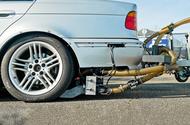Michelin’s rolling rig collects and filters tyre particle waste
Spent tyre particulates are becoming an environmental concern; Michelin’s new tech could change the industry
Euro 7 emissions regulations, the toughest yet, will come into force in July 2025.
As the emphasis shifts from combustion-engined vehicles, so the attention falls on other factors, such as non-exhaust particulate matter from tyres and brakes.
The new standards will be the first globally to move beyond tailpipe emissions and set limits for brake and microplastic tyre particles.
Naturally, tyre companies haven’t been sitting on their hands. Michelin has been researching tyre wear particulates for the past 20 years; in the UK, engineering consultancy Ricardo, working with Arup, last year published a report, prepared for the Department for Transport, on how to measure them.
The European Commission will produce a report by the end of this year to review measurement methods and the subject of tyre abrasion in general. The latest proposal is that emissions of PM10, which means particulates of 10 microns or less in diameter, will be limited to 3mg/km (3000th of a gram every kilometre, or roughly 5mg per mile).
How small is 10 microns? By comparison, a human hair is 50-60 microns in diameter. The smaller particulates get, the worse their potential effects: research indicates that ultra-fine particles (PM 0.1) are among the most damaging to human respiratory systems.
Regulating for something is one thing, but how do you set about measuring something so small? With a large vacuum cleaner, that’s how. Michelin has revealed what looks like a refreshingly straightforward way of measuring tyre particulates using suction and a two-stage measuring system.
The first part draws in air from the front of the test car to give a background measure of the ambient particulates from pollen, industrial and domestic heating and any other sources. This is then compared with the particulate samples taken from directly behind a tyre.
Each set of samples passes into a filtration system towed behind the car. This traps particles according to size, from 10 microns to six nanometres (a nanometre is one billionth of a metre).
The next stage is separation, where the source of the particles in each of the filters is identified using a pyrolysis process to isolate the tyre particles. Finally, the sampling phase quantifies the proportion of particles by size.
Michelin says it obtains less than 1% of PM10 and less than 0.6% of PM2.5 directly from the tyre, and the particles are a concoction of 50% tyre rubber and 50% minerals plus other road surface materials. The total particles produced by tyre wear that remain suspended in the air (known as aerosols) are on average 1.3% PM10 and just 0.16% PM2.5.
Michelin is sharing the design of its equipment with the rest of the tyre industry. The European Tyre & Rubber Manufacturers Association plans to conduct large-scale research starting this year, in collaboration with an independent third party.
Source: Autocar
